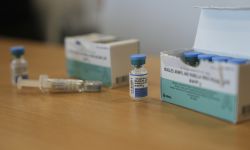As COVID deaths rise again in Michigan, its victims are changing
As Gov. Gretchen Whitmer extends a state “pause” on many school and business activities for 12 days, Michigan is moving through the deadliest phase of the coronavirus pandemic since April.
The state has reported over 800 deaths in December alone, and more than 2,600 since Nov. 1, following five months of relatively low mortality.
But the resurgence in deaths this autumn is unfolding in ways far different from when the virus killed nearly 5,500 people from March through May.
Deaths are now registering across the state, from the far reaches of the Upper Peninsula to southwest Michigan, from Alpena to metro Detroit.
The people succumbing to the virus have changed as well; they are more likely than in the spring to be older and white. Consider:
- While 40 percent of Michigan COVID deaths before Aug. 1 were African Americans, just 7 percent of deaths since Nov. 1 involve Black residents
- Whites, meanwhile, constitute 76 percent of the 2,741 confirmed or probable deaths since Nov. 1, up from 52 percent before August.
The virus barrelled through Detroit and its suburbs in March, April and May, but is now far more prevalent in other parts of the state where far fewer Black residents live, including the Upper Peninsula, and some western and south-central regions.
The populations of those regions also tend to be older. Roughly 50 percent of COVID deaths since Nov. 1 included people 80 or older. Before Aug. 1, this age group accounted for 43 percent of deaths.
Black people dying in this second wave are six years younger, on average, than white victims. The reduction in deaths among African Americans could be a factor in the rising average age among all COVID deaths, according to Ramya Naraharisetti, a University of Michigan researcher.
West Michigan has felt much of the surge. Most of the 166 COVID deaths recorded in Ottawa County are since Nov. 1.
“Here in Ottawa County we have seen a rising tide that has affected all of our demographics,” said Derel Glashower, Ottawa’s chief epidemiologist.
But fewer than 2 percent of Ottawa County residents are African American.
In contrast, in Detroit, which is 79 percent Black, just 3.4 percent of the more than 1,600 deaths since the pandemic hit were in the past five weeks.
After a crushing spring, Detroit, the state’s largest city, has had some of the lowest levels of positive tests, cases and deaths in the state in recent months, which experts attribute to Detroiters’ vigilance with masks and social distancing, hard-won lessons from the city’s earlier pain.
In Macomb County, where African Americans constitute nearly 13 percent of the population, the racial shift has been dramatic, said Scott Turske, a spokesman for the county health department.
In April, Black residents constituted 20 percent of COVID deaths in Macomb. But in November, that number plummeted to 3 percent.
- The latest: Michigan coronavirus unemployment, map, curve, updated COVID-19 news
- Dashboard: Michigan coronavirus testing numbers, trends, COVID-19 data
The virus has slammed Macomb County hard in recent weeks, but less so in southern Macomb, where Black residents are more prevalent. COVID-19 is now hitting Sterling Heights, Shelby and Macomb townships and other areas in the northern part of the county more heavily, county data show.
The state recorded its 10,000th death on Tuesday, but there has been a glimmer of good news in the past week.
Coronavirus case counts statewide have started to plateau or fall, as have the number of people hospitalized for treatment. Hospitalization rates rose from 700 on Oct. 1 to over 4,300 COVID patients at the beginning of last week. On Monday, that number had dropped to 4,122.
Glashower, the Ottawa epidemiologist, attributes some of the decline to the three-week “pause” on high school classes, restaurant dining and other businesses imposed by the Whitmer administration in mid-November. (Whitmer announced Monday the order would be extended until Dec. 20.)
The “orders are not hurting,” Glashower told Bridge. “They are probably contributing to that plateauing or the declining numbers.”
Public health officials say they are now looking to see if social gatherings at Thanksgiving will impact state trends in case numbers — and deaths — as residents look ahead to the December holiday season.
See what new members are saying about why they donated to Bridge Michigan:
- “In order for this information to be accurate and unbiased it must be underwritten by its readers, not by special interests.” - Larry S.
- “Not many other media sources report on the topics Bridge does.” - Susan B.
- “Your journalism is outstanding and rare these days.” - Mark S.
If you want to ensure the future of nonpartisan, nonprofit Michigan journalism, please become a member today. You, too, will be asked why you donated and maybe we'll feature your quote next time!








